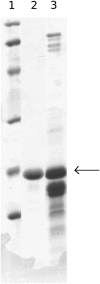Biophysical characterization of the unstructured cytoplasmic domain of the human neuronal adhesion protein neuroligin 3
- PMID: 18456828
- PMCID: PMC2483779
- DOI: 10.1529/biophysj.107.126995
Biophysical characterization of the unstructured cytoplasmic domain of the human neuronal adhesion protein neuroligin 3
Abstract
Cholinesterase-like adhesion molecules (CLAMs) are a family of neuronal cell adhesion molecules with important roles in synaptogenesis, and in maintaining structural and functional integrity of the nervous system. Our earlier study on the cytoplasmic domain of one of these CLAMs, the Drosophila protein, gliotactin, showed that it is intrinsically unstructured in vitro. Bioinformatic analysis suggested that the cytoplasmic domains of other CLAMs are also intrinsically unstructured, even though they bear no sequence homology to each other or to any known protein. In this study, we overexpress and purify the cytoplasmic domain of human neuroligin 3, notwithstanding its high sensitivity to the Escherichia coli endogenous proteases that cause its rapid degradation. Using bioinformatic analysis, sensitivity to proteases, size exclusion chromatography, fluorescence correlation spectroscopy, analytical ultracentrifugation, small angle x-ray scattering, circular dichroism, electron spin resonance, and nuclear magnetic resonance, we show that the cytoplasmic domain of human neuroligin 3 is intrinsically unstructured. However, several of these techniques indicate that it is not fully extended, but becomes significantly more extended under denaturing conditions.
Figures












Similar articles
-
Backbone and side chain NMR assignments for the intrinsically disordered cytoplasmic domain of human neuroligin-3.Biomol NMR Assign. 2012 Apr;6(1):15-8. doi: 10.1007/s12104-011-9315-4. Epub 2011 Jun 7. Biomol NMR Assign. 2012. PMID: 21647611 Free PMC article.
-
Evolution of clams (cholinesterase-like adhesion molecules): structure and function during development.Front Biosci. 2005 Sep 1;10:2177-92. doi: 10.2741/1689. Front Biosci. 2005. PMID: 15970486 Review.
-
The intracellular domain of the Drosophila cholinesterase-like neural adhesion protein, gliotactin, is natively unfolded.Proteins. 2003 Nov 15;53(3):758-67. doi: 10.1002/prot.10471. Proteins. 2003. PMID: 14579366
-
Characterization of the solution structure of a neuroligin/beta-neurexin complex.Chem Biol Interact. 2008 Sep 25;175(1-3):150-5. doi: 10.1016/j.cbi.2008.04.040. Epub 2008 May 4. Chem Biol Interact. 2008. PMID: 18550038 Free PMC article.
-
A practical guide to small angle X-ray scattering (SAXS) of flexible and intrinsically disordered proteins.FEBS Lett. 2015 Sep 14;589(19 Pt A):2570-7. doi: 10.1016/j.febslet.2015.08.027. Epub 2015 Aug 29. FEBS Lett. 2015. PMID: 26320411 Review.
Cited by
-
Comprehensive determination of (3)J (HNHalpha) for unfolded proteins using (13)C'-resolved spin-echo difference spectroscopy.J Biomol NMR. 2009 Dec;45(4):343-9. doi: 10.1007/s10858-009-9382-3. Epub 2009 Nov 7. J Biomol NMR. 2009. PMID: 19898942 Free PMC article.
-
Describing sequence-ensemble relationships for intrinsically disordered proteins.Biochem J. 2013 Jan 15;449(2):307-18. doi: 10.1042/BJ20121346. Biochem J. 2013. PMID: 23240611 Free PMC article. Review.
-
Context-dependent resistance to proteolysis of intrinsically disordered proteins.Protein Sci. 2011 Aug;20(8):1285-97. doi: 10.1002/pro.657. Epub 2011 Jun 8. Protein Sci. 2011. PMID: 21574196 Free PMC article. Review.
-
The folding of single domain proteins--have we reached a consensus?Curr Opin Struct Biol. 2011 Feb;21(1):12-24. doi: 10.1016/j.sbi.2010.11.002. Epub 2010 Dec 6. Curr Opin Struct Biol. 2011. PMID: 21144739 Free PMC article. Review.
-
Integrative structural dynamics probing of the conformational heterogeneity in synaptosomal-associated protein 25.Cell Rep Phys Sci. 2021 Nov 17;2(11):100616. doi: 10.1016/j.xcrp.2021.100616. Epub 2021 Oct 15. Cell Rep Phys Sci. 2021. PMID: 34888535 Free PMC article.
References
-
- Botti, S. A., C. E. Felder, J. L. Sussman, and I. Silman. 1998. Electrotactins: a class of adhesion proteins with conserved electrostatic and structural motifs. Protein Eng. 11:415–420. - PubMed
-
- Gilbert, M. M., and V. J. Auld. 2005. Evolution of clams (cholinesterase-like adhesion molecules): structure and function during development. Front. Biosci. 10:2177–2192. - PubMed
-
- Ichtchenko, K., Y. Hata, T. Nguyen, B. Ullrich, M. Missler, C. Moomaw, and T. C. Sudhof. 1995. Neuroligin 1: a splice site-specific ligand for β-neurexins. Cell. 81:435–443. - PubMed
-
- Gilbert, M., J. Smith, A. J. Roskams, and V. J. Auld. 2001. Neuroligin 3 is a vertebrate gliotactin expressed in the olfactory ensheathing glia, a growth-promoting class of macroglia. Glia. 34:151–164. - PubMed
Publication types
MeSH terms
Substances
Grants and funding
LinkOut - more resources
Full Text Sources
Molecular Biology Databases

